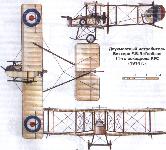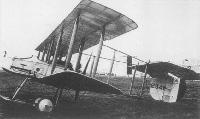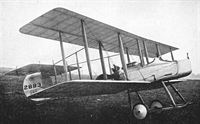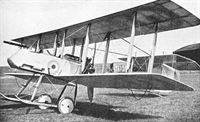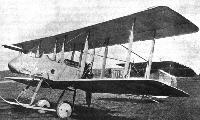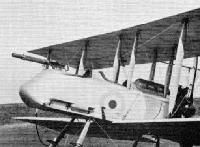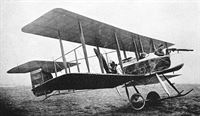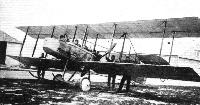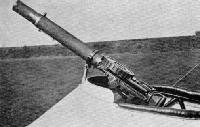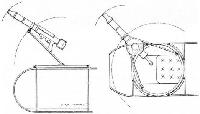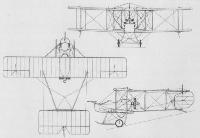В.Кондратьев Самолеты первой мировой войны
ВИККЕРС FB.5/9 "ГАН БАС" / VICKERS FB.5/9 GUN BUS
Известный британский оружейный концерн Виккерс одним из первых выдвинул идею вооруженного боевого самолета. В 1913 году на очередном ежегодном авиашоу Виккерс представил самолет FB.4 - двухместный биплан смешанной конструкции с толкающим винтом и шаровой установкой пулемета "Максим" в носовой оконечности фюзеляжной гондолы. Машина вызвала интерес, но не более. Официальных заказов не последовало.
Однако руководство фирмы сохраняло уверенность в перспективности аппарата и на свой страх и риск заложило в начале 1914-го серию в 50 экземпляров. При этом громоздкий и тяжелый "Максим" заменили более легким и удобным в обслуживании "Льюисом" на шкворневой установке. Самолет получил обозначение FB.5 и прозвище "Ган бас", что можно перевести как "вооруженная повозка".
Виккерс не ошибся в прогнозах, и с началом войны "Ган бас" был немедленно принят на вооружение. Правда, в первые месяцы боев отсутствие воздушного противника по-прежнему заставляло многих считать, что пулемет на самолете - всего лишь бесполезная нагрузка. В результате первый дивизион FB.5 прибыл на фронт только в феврале 1915-го. До июля самолеты вели воздушную разведку.
Потом ситуация резко изменилась. Появление у немцев истребителей Фоккера выявило беззащитность большинства английских машин перед этой новой угрозой. Поскольку "Ган бас" был единственным в RFC вооруженным самолетом, его переквалифицировали в истребитель! В таком качестве FB.5 применялся до конца года, сбив несколько германских аэропланов. Затем его вновь перевели в разведчики, а в июле 1916 сняли с вооружения.
В декабре 1915-го появилась новая модификация "Ган баса" - FB.9, также выпускавшаяся серийно. Она отличалась усовершенствованным шасси без противокапотажных лыж, турельный пулеметом и мотором повышенной мощности.
Небольшое количество этих машин использовалось на западном фронте и в учебных частях до начала 1917 года.
ДВИГАТЕЛЬ
"Гном-моносупап", 100 л.с.
ВООРУЖЕНИЕ
1 подвижный 7,7-мм "Льюис" на шкворневой или турельной установке в передней кабине, несколько мелких бомб.
А.Шепс Самолеты Первой мировой войны. Страны Антанты
Виккерс F.B.5 "Ганбас" (Gunbus) 1915 г.
Самолет создавался как разведчик и легкий бомбардировщик, по схеме был близок французским машинам фирмы "Фарман". Это был двухстоечный ферменный биплан с толкающим винтом.
Гондола имела деревянную конструкцию и фанерную обшивку. В носовой части стоял пулемет на шкворневой установке, за местом наблюдателя находилось место пилота, а затем топливный и масляные баки.
Несущая ферма имела смешанную конструкцию. Пояса фермы выполнялись из стальных труб, а стойки были деревянные. Растяжки фермы и бипланной коробки - стальной трос. Крыло двухлонжеронное, цельнодеревянной конструкции. Обтяжка - полотно. Крыло оборудовалось элеронами. Стойки бипланной коробки выполнялись из дерева. Горизонтальное оперение устанавливалось по верхнему поясу ферм, имело цельнодеревянную конструкцию и обтягивалось полотном. Руль поворота крепился к стойке, соединяющей фермы между собой, а перед ним устанавливался киль. Шасси обычной схемы с резиновой шнуровой амортизацией и хвостовым колесом, двигатель 7�цилиндровый, воздушного охлаждения, ротативный "Рон".
Хотя машина создавалась как разведчик и легкий бомбардировщик, но установка в носовой части гондолы пулемета позволила использовать машину для борьбы с неприятельскими самолетами и дирижаблями. Но к концу 1915 года у немцев появились истребители "Фоккер", превосходившие по летным качествам машины F.B.5, и к середине 1916 года оставшиеся машины были переданы в учебные дивизионы.
C.Andrews Vickers Aircraft since 1908 (Putnam)
<...>
In 1913, Type 18, the E.F.B.2, appeared as an unstaggered biplane with slight overhang on the top wings and with large celluloid windows in the sides of the nacelle. It was flown frequently at Brooklands by Capt Wood and Harold Barnwell during that year, and was powered by a 100 hp Gnome monosoupape rotary engine. E.F.B.3 or No. 18B appeared in December 1913 with the side windows deleted and with ailerons replacing the wing warping. It was shown at the 1914 Olympia Aero Show. An order for six modified No. 18Bs, known as Vickers Type 30s, was placed in December 1913 by the Admiralty. However, before delivery was effected the Type 18B design was still further improved; the contract was taken over by the War Office, and this led to the prototype E.F.B.5, which retained the semicircular tailplane characteristic of the early Type 18. When this latest variant went into production the tailplane was made rectangular, and various nacelle configurations necessitated by different armament mountings were tried before the familiar blunt nose of the standard F.B.5 emerged. At this time the F.B.5 was dubbed the Gunbus.
It will be noted at this time that the prefix E, signifying experimental, was dropped. The first F.B.5 Gunbus was delivered to No. 6 Squadron of the Royal Flying Corps at Netheravon in November 1914. In it the lighter and handier Lewis gun replaced the Vickers gun (One or two F.B.5s used by the Royal Naval Air Service retained the Vickers gun on a pivot mounting), which, however, continued to be used in the air war as a fixed weapon with the whole aeroplane aimed at the target. Before this happened, however, a satisfactory means had to be invented to enable a fixed gun to fire through a revolving tractor propeller. One of the earliest of such devices was, in fact, the Vickers-Challenger interruptor gear. By this time aviation had become an arm of the Services, tentatively at first for reconnaissance and later for air attack.
The Crayford works took over the production of Vickers aircraft in late 1914, and the first F.B.5s were delivered from there. Three aircraft comprised the initial delivery to Netheravon, but two were returned to Joyce Green to create the nucleus of the Air Defence of London. The first recorded use of a Gunbus in action was on Christmas Day 1914, when 2nd Lt M. R. Chidson with Corporal Martin as gunner took-off from Joyce Green to attack a German Taube monoplane and, according to circumstantial evidence, destroyed it. The type went to the Western Front, and the first F.B.5 to arrive there was Chidson's, he having been posted to No. 2 Squadron in France on 7 February, 1915.
In November 1915, 2nd Lt G. S. M. Insall was awarded the Victoria Cross for gallantry displayed after forcing down a German Aviatik reconnaissance machine while flying a Vickers Gunbus. Compelled by ground fire to land near the front lines of the Allies, Insall repaired the damage to his aeroplane during the night and returned next morning to his squadron. In spite of these and other successes, the Gunbus suffered in company with other Allied aircraft from the unreliability of the rotary engine, largely because servicing and maintenance in the early days were not of the high standard reached later.
Experimental work was carried out with the Gunbus concept, and the E.F.B.6 was a variant flown in 1914 with extended top wing, presumably to obtain more lift for load carrying, but was not proceeded with. Before that, an advanced project following the general configuration of the E.F.B. 1 Destroyer had been designed under the classification E.F.B.4.
The F.B.5A was fitted with the Le Rhone or Clerget engine of 110 hp, and at least four were constructed with armour-plated nacelles. Two F.B.5s were fitted with the experimental Smith static radial air-cooled engine, nominally of 140 hp, while another was equipped with floats for operation off water but before this could be tried was reconverted to standard form and flown back to France.
<...>
A replica F.B.5 Gunbus was made by the Vintage Aircraft and Flying Association (Brooklands) in 1966 to celebrate the centenary of the Royal Aeronautical Society. It was fitted with a 100 hp Gnome monosoupape rotary engine rebuilt from two surviving examples found in RAF redundant stores. This aeroplane flew faultlessly at the first attempt, piloted by D. G. Addicott, a Vickers test pilot. Despite its low power, the replica disclosed good handling qualities and is an existing testimony to the excellence of the design for the requirement of its day, which was to provide a steady gun platform for air offence.
F.B.5 (Gunbus)
Accommodation: Pilot and gunner
Engine: 100 hp Gnome monosoupape
Span: 36 ft 6 in
Length: 27 ft 2 in
Height: 11 ft
Wing Area: 382 sq ft
Empty Weight: 1,220 lb
Gross Weight: 2,050 lb
Max Speed: 70 mph at 5,000 ft
Service Ceiling:9,000 ft
Climb to: 5,000ft in 16min
Range: 250 miles
Armament: One Lewis
M.Goodall, A.Tagg British Aircraft before the Great War (Schiffer)
Deleted by request of (c)Schiffer Publishing
VICKERS EFB.4 and 5 and FB.5-FB.7 (Type 18 Variants)
Both the Admiralty and the War Office became interested in the Type 18, and a prototype was ordered by the Admiralty on Contract CP 03330/12/53661 dated 19 December 1912. This aircraft was the subject of much development by Vickers, and was presumably the aircraft, serial No.32 delivered in 1914, providing the identity, Admiralty Type 32, for naval aircraft ordered later.
The War Office apparently ordered one of each Type 18A and 18B on Contract No.A2033 in 1913. These may have been retained by the firm, or possibly, transferred to a further Contract No. A2321 dated 18 December 1913 for six Type 18B aircraft. These were development aircraft and may have been identified as Nos.FB2-FB.7, before the Type FB5 was finally selected for production. No.FB4, the FB5 prototype, became No.664 and FB6 became No.704 in service, the latter with a top wing of increased span, braced by cables and kingposts appearing at Brooklands in the early part of July 1914.
Production orders were to follow for both the RFC and the RNAS, by which time the FB.5 was colloquially known as the Gunbus.
Production of the FB.5 was carried out at Crayford, and the first delivery to the RFC was in September 1914. Many changes were made to the type, which continued in production into 1917, with the final FB.9 version. The aircraft was made under license also; in France and Denmark in wartime. The use of the armament was of prime importance, and the gun was eventually positioned on a pillar mounting, above the nacelle, involving several changes to the front of the nacelle before being finalized. The original semicircular tailplane was replaced by one of rectangular shape and finally the rudder was increased in area and acquired a curved trailing edge.
It is difficult to be certain of quantities built, partly owing to transfers of aircraft between the RFC and the RNAS and the renumbering that took place. However, it does appear that forty-eight production aircraft were on contract to Vickers to the end of 1914.
Variants of the basic type which were proposed included the EFB.4, the GFB. 1, 2 and 3, the latter three, including twin-engined versions, were for the German government, none of which were built.
Power: 100hp Gnome Monosoupape nine-cylinder air-cooled rotary.
Data for FB.5
Span 36ft 6in
Area 382 sq. ft
Length 27ft 2in
Height lift
Weight 1,2201b.
Weight allup 2,0501b.
Max speed 70 mph. at 5,000ft
Climb 16 min to 5,000ft
Ceiling 9,000ft
Range 250 miles
Armament Lewis gun.
VICKERS seaplane Type 43
A float seaplane, a biplane based on the EFB.5, was designed in 1914 as a potential 'Gunbus' for the RNAS. An earlier version had been based on the EFB.3. A Vickers machine-gun was mounted in the nose and 300 rounds of ammunition would have been carried
Data
Span 52ft 10in
Chord 5ft 6in
Wing area 468 sq. ft
Length 30ft 2in
Gross weight 2,020 lb.
Max speed 60 mph
P.Lewis British Aircraft 1809-1914 (Putnam)
Vickers Gunbus E.F.B.1 to F.B.6
<...>
The E.F.B.5 formed the prototype of the production F.B.5, but, strangely enough, reverted to steel struts while retaining the equal-span wings and curved tailplane. Foreseeing the likelihood of war, the Vickers Company decided to put the Gunbus into production in advance of official orders, and the machine was revised to become the F.B.5. A return was made to the wooden struts of the E.F.B.4; the curved tailplane was replaced by the rectangular type, which was simpler to produce, and well-curved vertical tail surfaces were fitted. The armament comprised a drum-fed Lewis gun, which proved lighter and far handier than the Vickers-Maxim weapon. The F.B.5 underwent official tests at Farnborough in July, 1914, and subsequently proved a useful addition to the strength of the R.F.C. Fifteen were used also by the R.N.A.S.
<...>
J.Bruce British Aeroplanes 1914-1918 (Putnam)
Vickers F.B.5
THE great Vickers concern had begun to take an active interest in aviation from the early part of 1911. Captain H. F. Wood was appointed technical adviser to the firm, and it was because of his enterprise that the company produced a series of monoplanes, the earliest of which were based upon the French R.E.P. design.
At the 1913 Aero Show which opened at Olympia in February of that year,. Vickers Ltd. displayed one of their monoplanes; but of far greater significance was a new pusher biplane exhibited on the same stand.
The latter aircraft had heavily staggered wings and was powered by one of the new 60-80 h.p. Wolseley engines. Let into the nose of the nacelle was a Maxim belt-fed machine-gun which was capable of limited movement.
This aeroplane was the forerunner of one of the first true fighting aircraft ever possessed by the British forces. Throughout 1913 and the first half of 1914 further variations on the basic theme appeared: later versions had the 100 h.p. Gnome Monosoupape engine; the staggered wings were not repeated; various nacelle shapes were tried, as were wing designs, some with ailerons, others with warping. But the gun was always there in the nose of the nacelle, whence it had uninterrupted forward fire.
All the early Vickers gun-carriers were armed with a Maxim or Vickers belt-fed gun on a kind of ball and socket mounting, and it came to be realised that this arrangement was not ideal. The nature of the mounting prevented the taking of any kind of aim and limited the movement of the gun; within the cockpit the gun and its belt of ammunition gave rise to some difficulties of stowage.
By 1914, therefore, when the Vickers F.B.4 appeared, a change had been made in the armament: there was provision for carrying a Lewis drum-fed machine-gun on a kind of spigot just in front of the gunner’s cockpit. Thus he was provided with a free and flexible weapon. The F.B.4 was the design from which the F.B.5 was developed.
The aircraft’s full designation signified Vickers Fighting Biplane No. 5. The two-bay wings were of equal span; the large rectangular tailplane was at the level of the upper tail-booms; the undercarriage embodied two longitudinal skids; and the engine was a 100 h.p. Gnome Monosoupape. The nacelle was neater than that of any earlier Vickers gun-carrier and had an aluminium nose. It offered scant protection to the observer, whose Lewis gun was carried on a pillar mounting at the extreme front of his cockpit. At least one F.B.5 had a modified nacelle with a more pointed “chin”, but this did not become a standard feature.
Vickers Ltd. were convinced of the value of their two-seat fighter and were equally certain that war was imminent. With a degree of foresight that has only one equal in history (namely, the laying down in 1939 of Hawker Hurricanes that had not been ordered by the Government), Major Wood began construction of a batch of fifty F.B.5s in 1914.
The F.B.5 was tested at Farnborough in July 1914 and was well reported on. Official orders were then placed for the type; but not without misgiving, for it was an untried design powered by what was then an untried engine. In its earliest form the F.B.5 had a rudder with a straight vertical trailing edge, but an enlarged rudder of rounded outline was soon substituted and remained standard.
At the outbreak of war the R.N.A.S. had on its strength a Vickers biplane with a Monosoupape engine: whether this was an F.B.5 or one of its immediate predecessors is uncertain.* The first F.B.5 to go to France arrived there on February 5th, 1915, and others soon followed. One was with No. 16 Squadron on March 10th, 1915, but most of the others were allotted to No. 5 Squadron. In the R.F.C. the F.B.5 was known as the Vickers Gun Bus.
* To the R.N.A.S. the Vickers F.B.5 was known as Vickers Type 32, from the first machine’s serial number. Two batches numbered 861-864 and 3595-3606 were later supplied to the R.N.A.S.
But the F.B.5s which went to France were not the first to go into action against enemy aircraft. On Christmas Day, 1914, a German seaplane came in over Sheerness at 12.35 p.m. and flew up the Thames as far as Erith, pursued by three R.N.A.S. aeroplanes from Eastchurch and Grain. One of the first Vickers F.B.5s went up from Joyce Green to engage the enemy, but the engine was troublesome, the Lewis gun jammed, and the gallant gunner had his hands frost-bitten - in his haste he had forgotten his gloves. The enemy escaped.
The early Gnome Monosoupapes gave a good deal of trouble. Those fitted to the Vickers F.B.5s were British-made and were by no means reliable. Writing in April, 1915, Lieutenant-Colonel H. R. M. Brooke-Popham reported: “A case has recently been brought to my notice where a pilot has had 22 forced landings in 30 flights in a Vickers machine.” Fortunately the troubles were not chronic or incurable, and once the Monosoupape was understood it gave good service.
The Vickers F.B.5 did not at first form the exclusive equipment of any squadron, but a few machines were attached to units with the intention of providing fighter protection for the reconnaissance aircraft.
On April 8th, 1915, No. 7 Squadron arrived in France with two Flights of R.E.5s and one of Vickers F.B.5s, but the Vickers were quickly replaced by Voisins. By May 9th, No. 5 Squadron was the only unit with any F.B.5s on strength: its equipment on that date consisted of five Vickers F.B.5s, six Avro 504s and one Martinsyde S.1.
On July 25th, 1915, the first homogeneous fighter squadron to join the B.E.F. arrived in France. It was No. 11 Squadron, R.F.G., and it was equipped throughout with Vickers F.B.5s. This famous squadron did not confine its activities to fighting, but also carried out long reconnaissances, photography and occasional artillery observation flights.
With No. 11 Squadron the Vickers F.B.5 gave an excellent account of itself, despite its meagre performance. The pilots found that it was immensely strong, for the basic structure, including the tailbooms, was of steel tubing. The number of enemy aircraft shot down by the F.B.5s was not large, but enemy pilots had a wholesome respect for the sturdy old pusher and seldom tried conclusions with it.
On November 7th, 1915, Second Lieutenant G. S. M. Insall of No. 11 Squadron won the Victoria Cross for an action in a Vickers F.B.5. He and his observer, Air Mechanic T. H. Donald, forced down an Aviatik two-seater and completed its destruction by dropping an incendiary bomb on it. Crossing the lines at low level, the Vickers came under heavy fire; its tank was pierced and the engine stopped. Insall landed 500 yards inside the French lines, and his F.B.5 was immediately shelled by the enemy. Fortunately the machine was not hit, and after nightfall it was repaired. At dawn next day Insall flew it back to his squadron’s aerodrome.
On November 19th, 1915, No. 18 Squadron arrived in France equipped with Vickers F.B.5s, but had them for a short period only before being re-equipped with F.E.2b’s. By that time the Vickers had been outclassed by the Fokker Monoplane with its synchronised machine-gun. Indicative of the circumstances were the experiments made with one of the F.B.5S of No. 11 Squadron early in 1916: these were the earliest attempts to produce a double-yoked pair of Lewis guns.
No. 11 Squadron still had four Vickers F.B.5S on its strength on July 1st, 1916, but by then the old warrior was hopelessly outmoded. After its withdrawal from fighting duties the F.B.5 gave excellent service with the training squadrons, for it was a viceless flying machine.
The only known experimental variants of the F.B.5 appeared in the summer of 1915. An armoured version of the type was delivered to Upavon; it was powered by the first 110 h.p. Clerget engine to reach this country. The engine gave a good deal of trouble, however, and the armoured F.B.5 did not go into production. Two experimental F.B.5s were supplied to the Admiralty. They were numbered 1534 and 1535, and were powered by the 150 h.p. Smith radial engine: the first machine was accepted at Eastchurch on August 7th, 1915. Apparently the two aircraft differed slightly, but neither was developed.
SPECIFICATION
Manufacturers: Vickers, Ltd. (Aviation Department), Imperial Court, Basil Street, Knightsbridge, London, S.W.
Power: 100 h.p. Gnome Monosoupape. 110 h.p. Clerget. 150 h.p. Smith Static.
Dimensions: Span: 36 ft 6 in. Length: 27 ft 2 in. Chord: 5 ft 6 in. Gap: 6 ft. Stagger: nil. Dihedral: 1°. Incidence: 4° 30'. Wheel track: 5 ft 10 1/2 in.
Areas: Wings: upper 197 sq ft, lower 185 sq ft, total 382 sq ft. Ailerons: each 14-25 sq ft, total 57 sq ft. Tailplane: 56 sq ft. Elevators: 24-6 sq ft. Fin: 8-5 sq ft. Rudder: 13-25 sq ft.
Weights: Empty: 1,220 lb. Military load: 40 lb. Crew: 360 lb. Fuel and oil: 430 lb. Loaded: 2,050 lb.
Performance: Maximum speed at 5,000 ft: 70 m.p.h. Climb to 5,000 ft: 16 min. Service ceiling: 9,000 ft. Endurance: 4 1/2 hours.
Armament: One Lewis machine-gun on pivoted mounting at front of observer’s cockpit, occasionally augmented by a rifle or revolver. One Vickers F.B.5 of No. 11 Squadron had an experimental installation of a pair of Lewis guns. Light bombs could be carried.
Service Use: Western Front: R.F.C. Squadrons Nos. 2, 5, 7, 11, 16 and 18; No. 1 Squadron, R.N.A.S. (had one Vickers Fighter on February 26th, 1915). Training: No. 10 Reserve Squadron, Joyce Green; No. 24 Squadron, Hounslow.
Production and Allocation: Official statistics indicate that 241 Vickers F.B.5S were distributed to units of the R.F.C. It seems possible, however, that that total may include re-allocations to training units, to which 131 were delivered. To the squadrons with the B.E.F. went 109 F.B.5S: sixty in 1915 and forty-nine in 1916; and one went to the Middle East in 1917.
Serial Numbers: 32. 861-864: ordered under Contract No. C.P.O.2132/14/X(A). 865-872: originally ordered for Admiralty under Contract No. C.P.O.2132/14/X(A) but transferred to R.F.C. 1534-1535: supplied to Admiralty with 150 h.p. Smith engine under Contract No. 47886/15/X(A). 1628-1639: ordered under Contract No. A.2705 (M.A.3). 1640-1651: ordered under Contract No. A.2866 (M.A.3). (Apparently the serial numbers 1648-1651 were re-allocated after the cancellation of the B.E.10s for which the numbers were originally allotted.) 2340-2347: ordered under Contract No. A.2978. 2870-2883: ordered under Contract No. A.2974 (M.A.3). 3595-3600: ordered under Contract No. C.P.58733/15/X(A). 3601-3606: ordered under Contract No. 87/A/210 (M.A.3). 4736: ordered under Contract No. A.2978. 5618-5623 and 5649-5692: ordered under Contract No. 87/A/107.
P.Lewis The British Fighter since 1912 (Putnam)
Immediately following the E.F.B.3 came the E.F.B.4 which had fabric sides to the nacelle, cable-connected ailerons and wooden interplane, centre section and upright struts between the tail booms in place of metal used so far. The undercarriage was enlarged but perhaps the most significant difference was that the gun had been raised from its trunnion form of mounting onto a pillar to give completely free movement in aiming.
The next Gunbus, the E.F.B.5, was the final prototype for the production F.B.5 and reverted to steel struts, combined with equal-span wings and curved tailplane. An official order had still not been received for the Gunbus but Vickers, sensing that war was but a short time away, took the step of putting a batch of fifty of the type into production on their own responsibility as the F.B.5. Once again the design was altered before it was ready for its tests at Farnborough in July, 1914. To simplify production a rectangular tailplane was substituted; wooden struts were fitted again and the vertical tail was of well-rounded outline. The Vickers-Maxim gun had not proved to be the handiest of weapons for such an installation and was replaced by the lighter and more flexible Lewis with its drum cartridge feed.
<...>
In company with their fellow British aircraft constructors, the Vickers company continued their efforts to produce an effective fighting machine. Their F.B.5, after being used in small numbers by one or two squadrons flying with mixed types, finally reached the Front as the sole equipment of one unit when No. 11 Squadron, R.F.C., arrived on 25th July, 1915, soon after finding its feet with its sturdy pushers. Experimental versions of the F.B.5 Gunbus which appeared in mid-1915 included an armoured example, fitted with the first of the 110 h.p. Clergets to arrive in Britain, and two for the Admiralty - Nos. 1534 and 1535 - both fitted with the more powerful 150 h.p. Smith Static radial engine. All three remained as prototypes and the Vickers design staff turned their attention to something more advanced.
F.Mason The British Fighter since 1912 (Putnam)
Vickers F.B.5 Gunbus
Although the evolution of the initial production version of the Vickers F.B.5 Gunbus has been shown to have followed a natural progression by means of the E.F.B. series of experimental designs, a number of complicating design considerations were necessarily introduced as the reality of production approached. Not unnaturally the manufacturers were at pains in overcoming these complications not to compromise the aircraft’s excellent handling characteristics which had, after all, attracted both the Admiralty and War Office.
To begin with the gun mountings that had appeared in the E.F.B.2 and 3 were clearly unsatisfactory and tended to suggest that Vickers’ own machine gun was not suitable for this class of gun carrier owing to the untidy belt-fed arrangement and the difficulty of aiming the trunnion-mounted gun. Accordingly a new experimental design appeared (the E.F.B.4) in which a drum-fed Lewis gun was to be mounted on a spigot immediately forward of the gunner’s cockpit. While this was regarded as an acceptable compromise, diehard opponents pointed to the necessity to change drums frequently owing to their 97-round capacity. It also led to substantial redesign of the Gunbus nose, and required the gunner to stand exposed while aiming and firing the gun.
Other production considerations had to be faced, and extensive changes in the wing and tail planforms were adopted in the interests of simpler and quicker manufacture. The wing chord was increased and given square tips, while the familiar semi-circular tailplane was replaced by a huge rectangular surface; the rudder was also increased in area.
As already stated, a production order for twelve E.F.B.3s had been placed by the Admiralty in 1914, but these were taken over by the War Office at the outbreak of war, and the original E.F.B.3 is believed to have undergone progressive modification to become the E.F.B.5, or prototype F.B.5, but retained the curved tailplane leading edge.
Convinced that war was imminent, and that the Gunbus would be demanded in substantial numbers, Major Wood recommended that Vickers should begin manufacturing fifty production aircraft without waiting for Service contracts. These were in due course covered by three orders, covering 46 aircraft for the RFC, and two orders covering four Admiralty aircraft. Two of the latter were delivered early in 1915 with 150hp Smith engines.
The Gunbus first flew against the Germans when, on Christmas Day 1914, a German seaplane flew up the Thames Estuary towards London. An F.B.5 took off from Joyce Green but failed to engage, partly due to a faltering engine. The first of the Vickers aircraft to go to France arrived on 5 February 1915 but, such was the infancy of military aviation, squadrons were not yet specialists in any recognised air fighting role, and each possessed a variety of different aircraft, and none was initially wholly equipped with F.B.5s. Those that did possess examples in those early months in France were Nos 5 and 16 Squadrons.
At home, however, the RFC had begun to recognise the need to establish squadrons equipped with aircraft armed with an in-built gun, capable of defending itself without recourse to hand-held small arms. The Gunbus, relatively simple to fly, fairly manoeuvrable, and available in fast growing numbers, was an obvious choice to equip the first specialist fighting scout squadron and, on 11 July, No 11 Squadron (commanded by Maj George William Patrick Dawes, later DSO, afc) arrived in France with a full complement of F.B.5s.
Despite its very modest performance, and the appearance of the early Fokker monoplanes - with their synchronized front gun - the Gunbus acquitted itself well, particularly against enemy aircraft of its own vintage. It was on 7 November 1915 that 2/Lieut Gilbert Stuart Martin Insall of No 11 Squadron won the Victoria Cross for an action involving the destruction of an Aviatik. Having forced the enemy aircraft down he then dropped an incendiary bomb on it. His own aircraft was then damaged by ground fire and was forced to land in the French lines. The following night, despite coming under enemy artillery fire, Insall and his observer repaired the Gunbus and at first light flew it back to their own airfield.
With the increasing ascendancy of German fighting scouts late in 1915, the Gunbus became hopelessly outclassed, but the F.B.5 soldiered on for a further six months until replaced by new Allied fighters. No 11 Squadron received its first Nieuport 13s in March 1916, but did not give up its F.B.5s until July. All told, Gunbuses equipped eight RFC squadrons, of which Nos 2, 5, 7, 11, 16 and 18 flew them in France.
A variant of the Gunbus was the F.B.5A, of which four examples were produced. These possessed armoured nacelles and were powered by 110hp Clerget engines but, being as yet relatively untried, these engines gave trouble and this version was not pursued further.
Unfortunately no accurate figures for total production of the Gunbus have been traced, and it is believed that the number was around 210; rather higher figures, sometimes quoted, are thought to have been confused by inclusion of aircraft withdrawn from France to join training squadrons, and therefore duplicated.
Type: Single pusher engine, two-seat, two-bay fighting biplane.
Manufacturer: Vickers Ltd (Aviation Dept), Knightsbridge, London.
Powerplant: One 100hp Gnome monosoupape engine driving two-blade pusher propeller;also 110hp Clerget (F.B.5A); 150hp Smith Static.
Structure: Steel tubular structure with fabric covering; twin wheel and twin skid undercarriage.
Dimensions: Span, 36ft 6in; length, 27ft 2in; height, 11ft 0in; wing area, 382 sq ft.
Weights: Tare, 1,220lb; all-up, 2,050lb.
Performance: Max speed, 73 mph at sea level; climb to 5,000ft, 16 min; endurance, 4 1/2 hr.
Armament: One 0.303in Lewis machine gun on spigot mounting in front of observer’s cockpit.
Prototype and Production: One prototype, No 32. Known production aircraft: Nos 648, 664, 681 (3); Nos 861-872 (12); 1534-1535 (2); 1615-1651 (36); 2338-2347 (10); 2865- 2868 (4); 2870-2883 (14); 3595-3606 (12); 4736 (1); 5074-5075, 5078-5079, 5083-5084, 5454-5503 (56, built by Darracq), 5618-5623 (6); 5649-5692 (44); 5729 (1), 7510-7519 (10, possibly not all completed).
Summary of Service: F.B.Ss served with Nos. 2, 5, 7, 10 (Reserve), 11, 16, 18 and 24 Squadrons, RFC; No 1 Squadron, RNAS. One aircraft to the Middle East in 1917.
W.Green, G.Swanborough The Complete Book of Fighters
VICKERS F.B.5 GUNBUS UK
Progressive changes introduced by successive E.F.B.3s led to the E.F.B.5 - the E.F.B.4 being a project with a more streamlined nacelle centred between the wings and only two tailbooms - which was flown from Joyce Green to Brooklands on 17 July 1914. In parallel, Vickers developed the E.F.B.6, which, basically similar to the E.F.B.5, had longer-span upper wings. It lacked top decking between the two crew seats and had ailerons in the upper wings only. At Brooklands on 14 July 1914, the E.F.B.6 was taken on strength by the Royal Flying Corps when World War I began, but was not developed. The E.F.B.5, on the contrary, was ordered into production for both the RFC and the RNAS on 14 August 1914, the first series aircraft being completed in the following October. At this time, the aircraft became simply F.B. (Fighting Biplane) 5 and was dubbed Gunbus. The E.F.B.5 had retained the semi-circular tailplane of the E.F.B.2 and early E.F.B.3, but the series F.B.5 had an enlarged tailplane of rectangular planform and a larger rudder. A Lewis gun on a more practical mount supplanted the similar-calibre Vickers in the nose and the standard power plant was the 100 hp Gnome Monosoupape nine-cylinder rotary. The first F.B.5 reached the Western Front early February 1915, and, on the following 25 July, the first squadron of any air service formed specifically for fighting duties and equipped throughout with a single aircraft type arrived in France, this being the RFC’s No 11 Sqn with F.B.5s. The RNAS made little use of the F.B.5, and, after the delivery of four to that service, the large majority of subsequent deliveries went to the RFC, although the RNAS did receive two further F.B.5s which, ordered in May 1915, were fitted with the 150 hp Smith Static radial engine, its large diameter propeller necessitating the raising of the fuselage nacelle several inches above the lower wing. Two hundred and forty-one F.B.5s were delivered to the RFC, of which 109 were sent to the British Expeditionary Force in France (60 in 1915 and 49 in 1916). Licence production of the F.B.5 was undertaken in France by the Societe Anonym Darracq (which built a total of 99 of these and the later F.B.9) between May 1915 and June 1916. Twelve were also built under licence in Denmark in 1917-18 by the Tojhusvseiksted. At least four F.B.5As were built with armour-plated fuselage nacelles and these were powered by 110 hp Clerget 9Z nine-cylinder rotary engines and had oleo undercarriages. Suffering an unreliable engine and a marginal performance throughout its operational career, the F.B.5 was finally withdrawn from the Western Front in the autumn of 1916, being subsequently confined to RFC instructional units.
Max speed, 70 mph (113 km/h) at 5.000 ft (1525 m).
Time to 5,000 ft (1525 m), 16.0 min.
Service ceiling, 9.000 ft (2 745 m).
Endurance, 4.5 hrs.
Empty weight. 1,220 lb (553 kg).
Loaded weight, 2,050 lb (930 kg).
Span, 36 ft 6 in (11,13 m).
Length. 27 ft 2 in (8,28 m).
Height, 11 ft 1 in (3.38 m).
Wing area, 382 sq ft (35.49 m2).
H.King Armament of British Aircraft (Putnam)
<...>
It will thus be seen that much ingenuity was applied to the earliest members of the family of aircraft which came to be known by the name 'Gun Bus' during 1914. Yet on the E.F.B.5 prototype, the gun mounting was of simple trunnion type, carried above a fairing built up from the shallow nose of the redesigned nacelle. Thereafter F.B.5s had various types of simple mounting, sometimes associated with variations in nacelle shape. The real significance of the reversion to a simple form of mounting may well have been an aerodynamic one, governed by considerations of side area rather than arcs of fire, for the pusher-type of biplane, with its tail carried on booms, must have been especially sensitive in this regard. Indeed, when the prototype E.F.B.5 arrived at Brook lands in July 1914 it was remarked that this 'latest Vickers gun-carrier, which may be regarded as the outcome of the experimental work carried out on the previous gun-carrier' embodied the modifications in side area dictated by those experiences'.
A small number of F.B.5s used by the RNAS were armed with a Vickers gun on a trunnion mounting and one machine so armed was captured intact by the Germans. Thereafter the Vickers gun was to suffer almost total eclipse as a free-mounted weapon, and the redesigned nacelle of the Gun Bus was an early factor in bringing this about, for the Lewis gun was far more easily handled in an exposed position.
Various forms of pillar or pylon mounting were fitted to Gun Buses in service, and with the four machines designated by C. F. Andrews (Vickers Aircraft since 1908, Putnam, 1969) as F.B.5A a new type of mounting was associated. This mounting was designed by G. H. Challenger, and for the first time the mounting was of ring form. The ring was rotatable and the gun was carried on a V-shaped frame, to which it was pivoted. The frame projected beyond the diameter of the ring to permit the gun to be fired vertically downward. Vickers made mention of 'counter-balancing springs', enabling the frame to be readily raised and lowered, and also of means for locking it in any desired position. The gunner could raise and lower the frame with the hand he employed for firing the gun and training it round its pivotal connection on the arm, thus leaving his other hand free to rotate the ring.
It has been said of the Scarff ring-mounting that it was the first mounting which allowed for the gun to move round the gunner, instead of vice versa. This, however, was not the case, for the Vickers-Challenger mounting dated from the early summer of 1915, whereas the Scarff ring-mounting was developed in 1916. As events turned out, a number of F.B.5 Gun Buses were later converted as gunnery trainers, fitted with the Scarff ring-mounting.
For his original ring-mounting, Challenger developed early in 1916 a quite elaborate balancing system. Movement of the gun in elevation was compensated for the resultant moment due to air resistance and the weight of the gun, and movement of the gun in traverse was compensated for the moment due to air resistance. The elevation-compensating device was a spring-controlled chain arranged between the ring and an extension of one of the arms. The chain passed round one or other of a pair of pulleys, according to the position of the gun in elevation. The spring thus increasingly opposed motion on each side of a certain central position corresponding to the angle of gun elevation at which air resistance was exactly balanced by the weight of the gun. The traverse-compensating device comprised a spring-controlled chain and pulleys, arranged to give a central position when the gun was pointed ahead and increasingly opposed movement of the gun to the right or left of this position. Later in 1916 Vickers developed the mounting by introducing a spring-controlled crank, moving synchronously with the gun.
O.Thetford British Naval Aircraft since 1912 (Putnam)
VICKERS ADMIRALTY TYPE 32 GUNBUS
The F.B.5 Gunbus, the first British two-seat fighter aeroplane, made its appearance In 1914. It was used mainly by the RFC but over 20 were delivered to the RNAS beginning with No.32. This resulted in the aeroplane being known as the Type 32 in the RNAS. Subsequent serials were 861 to 872, 1534 to 1535 and 3595 to 3606. Nos.l and 4 Squadrons of the RNAS used at least one Gunbus each in France in 1915, but there is no operational record of other naval Gunbuses. One 100 hp Gnome Monosoupape engine. Loaded weight, 2,050 lb. Maximum speed, 70 mph at 5,000 ft. Service ceiling, 9,000 ft. Span, 36 ft 6 in. Length, 27 ft 2 in.
A.Jackson British Civil Aircraft since 1919 vol.3 (Putnam)
Vickers F.B.5 Gunbus replica
Two seat fighter first flown in 1914 and used by the R.F.C. in France until 1916. One replica aircraft, G-ATVP, c/n VAFA.01, built at Weybridge 1966 by the Vintage Aircraft and Flying Association to honour the centenary of the R.Ae.S. Its 100 h.p. Gnome Monosoupape was built from two stored engines. First flown by D. G. Addicott at Wisley 14.6.66 with serial 2345 and took part in the R.Ae.S. centenary display at Cranfield 19.6.66. Presented to the R.A.F. Museum, Hendon in 1969.
Span, 36 ft. 6 in. Length, 27 ft. 2 in. Tare wt., 1,220 lb. A.U.W., 2,050 lb. Max. speed, 70 m.p.h. Range, 250 miles.
Журнал Flight
Flight, June 12, 1919.
"MILESTONES"
THE VICKERS MACHINES
AT the outbreak of hostilities in August, 1914, the whole of the Technical Offices and the Drawing Office staff of the Aviation Department of Messrs. Vickers, Ltd., were transferred from Vickers House to the Crayford Works. The work on experimental seaplanes, of which two were under construction, was abandoned, and all efforts concentrated on the Vickers Fighter F.B. 5, which was the only definitely offensive aeroplane then in existence. This was familiarly known as -
"The Vickers Gun-'Bus"
With his usual foresight, the late Major Wood, having finished exhaustive tests, had a batch of 50 F.B. 5's actually in construction. These machines were fitted with the 100 h.p. monosoupape engine, of which Major Wood, realising its worth, had already ordered a great number.
Up to this time the armament of aeroplanes had not received much attention, either by the Services or designers. The chief functions of the R.F.C. had been that of carrying out reconnaissance flights and the dropping of small bombs. Fighting in the air, as understood to-day, did not exist, and although observers sometimes armed themselves with Service rifles or revolvers for cases of emergency, machines very seldom approached sufficiently near to one another to exchange shots. The advent of the Vickers F.B. 5 marked an epoch in the history of aeronautics, being the first fighting aeroplane, and was destined to influence the whole of aerial operations at the Front.
As is generally known, this machine was of the pusher type, and it was therefore possible to mount a Vickers gun in the nose of the nacelle, commanding an unobstructed and very wide range of fire.
It was the arrival of this machine on the Western Front which established for the first time our aerial supremacy. This supremacy, thanks largely to the "Gun-'bus," lasted for many months, in fact until the Fokker, with its synchronised gun arrived to dispute it. In spite of this, however, Vickers Fighters remained in commission as late as March, 1916, and their work was of the greatest value.




